Motion Detection with Pan-Tilt-Zoom Cameras using Background Mosaics
Topic Description
Accurate and reliable motion segmentation of video sequences is widely recognized as being the first stage of many video processing applications; visual surveillance and traffic monitoring make no exceptions.
Motion segmentation is accomplished using the background subtraction technique which is known as offering the best tradeoff between the quality of the detected moving masks and the computational cost, at least when using conventional stationary cameras. Using this approach basically means comparing the current frame with a reference scene (a previously computed background). Moving “blobs” (aggregate of pixels) are identified by thresholding these differences.
Many attempts have been accomplished to improve the overall performance of motion detection systems, by improving the background differencing techniques, exploiting color information or using PTZ cameras to widen the surveyed area. However, the methods usually employed to perform background difference cannot be extended “as is” to work with hinged Pan-Tilt-Zoom cameras. Extending background subtraction algorithms requires to have a background mosaic at one’s disposal.
Methodology
This work describes a general purpose framework that has been devised to perform motion detection in visual surveillance applications by using a PTZ camera. This has been realized by developing an efficient color based background mosaicing algorithm. The algorithm has been conceived to be completely image-based, meaning that it does not rely on any prior information regarding camera intrinsics (focal length, distortion coefficients), scene geometry or feedback signals coming from the imaging device (pan/tilt angular movements, exposure settings). This choice yields the algorithm to be hardware independent, thus resulting in a general-purpose approach.
Results
Experiments have been accomplished to assess the quality of the detected moving masks and to evaluate computational time performance. Afterwards, some sample frames are reported, moving people are highlighted in green. The background subtraction is performed in near real-time (5/7 frames per second) comparing the actual frame and the corresponding region of the background mosaic. It should be noted that the background mosaic can be acquired on-the-fly with people moving in the scene, however in this case convergence might be slower.
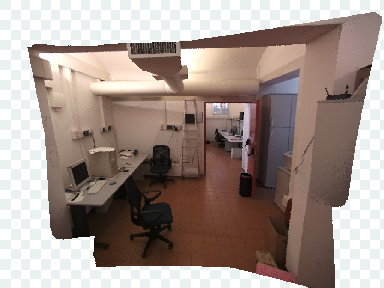 |
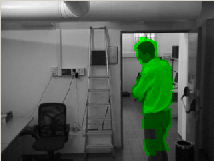 |
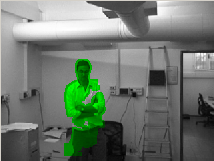 |
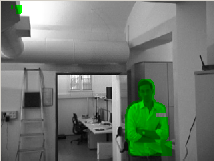 |
| Indoor mosaic (742 frames) | Motion masks (at frame 883, 977, 1071) | ||
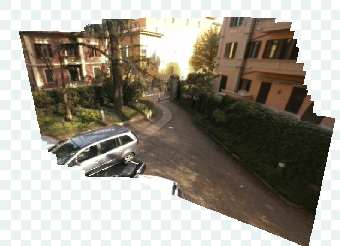 |
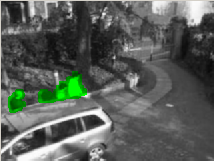 |
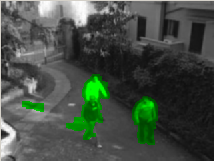 |
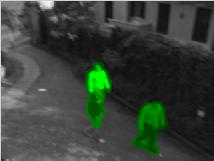 |
| Outdoor mosaic (687 frames) | Motion masks (at frame 828, 874, 886) | ||
Research Directions
While online computation of the background received a lot of attention in the visual surveillance community since the scene might change appearance quickly, nowadays background modeling and updating technique nearly vanish these efforts. Current research lines are oriented toward the design of procedures and models for background scene reconstruction able to handle in a principled manner:
- photometric phenomenas such as illumination variations due to the hour of the day, global and local illumination changes
- non planar, approximately planar or piecewise planar scenes
For further information regarding advanced methods for change detection please visit the research page dedicated to Real-Time analysis of image sequence.
References
| [1] | P. Azzari, General purpose real-time image mosaicing, appeared in the poster session of ICVSS, July 2007. |


